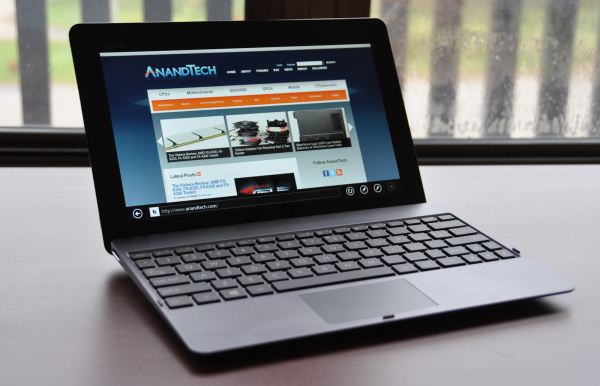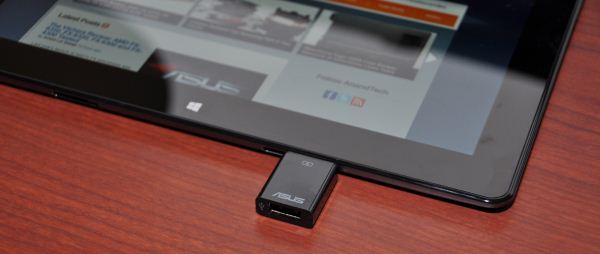ASUS VivoTab RT Review
by Vivek Gowri on October 23, 2012 3:01 PM EST- Posted in
- Asus
- Mobile
- Tablets
- Windows RT
- Vivo Tab
The ASUS Transformer line of tablets have consistently been among the strongest contenders in the Android tablet world, so when it was announced that they would be one of the launch partners for Microsoft’s Windows-on-ARM push, big things were expected. And so we have the ASUS VivoTab RT. The VivoTab name comes from the Latin verb “to live”, while the RT part is of course an indication of Windows RT, the official name for the ARM version of Windows. Windows RT-based tablets are Microsoft’s first real competitors built for the modern tablet market, so this is a hugely important launch for Microsoft as well as its hardware partners. Obviously the elephant in the room here is Surface and how Microsoft entering the hardware market changes the Windows 8/RT launch, but we’ll get to that part in time.
The division of Windows 8 (x86) and Windows RT (ARM) has resulted in a whole host of tablets with names ending in RT, and very similarly named examples running the x86-based Windows 8, so it’s worth keeping track of. For example, the VivoTab is x86-based, with Windows 8, Clover Trail, and an 11.6” display, a completely different product than the VivoTab RT that we have in front of us today. The RT is very important in making the distinction between ARM and x86 hardware platforms.
At first glance, the VivoTab RT looks pretty similar to what we’re used to seeing from the Transformer line, with a 10.1” IPS 768p display housed in a slim aluminum chassis and Nvidia’s Tegra 3 silicon underhood. The specsheet is actually pretty similar to the original Transformer Prime from last December, sharing identical width and thickness dimensions in addition to the obvious hardware-level similarities. The Transformer tablets have all been either 1280x800 or 1920x1200, so the switch to a 16:9 screen has allowed ASUS to make the VivoTab RT a bit shorter, as well as 60g lighter, than the Transformer Prime. At 1.15lbs, the VivoTab RT is quite the featherweight, helped along in this by the nano molding technology that injects liquid plastic to fuse the aluminum frame with the plastic components.
| Tablet Specification Comparison | ||||||
| ASUS VivoTab RT | Microsoft Surface for Windows RT | ASUS Eee Pad Transformer Prime | ASUS Transformer Pad Infinity | |||
| Dimensions | 263mm x 171mm x 8.3mm | 275 x 172 x 9.4mm | 263 x 180.8 x 8.3mm | 263 x 180.6 x 8.4mm | ||
| Chassis | Aluminum + Plastic | Magnesium | Aluminum | Aluminum + Plastic | ||
| Display | 10.1-inch 1366 x 768 Super IPS+ | 10.6-inch 1366 x 768 | 10.1-inch 1280 x 800 Super IPS+ | 10.1-inch 1920 x 1200 Super IPS+ | ||
| Weight | 525g | 680g | 586g | 594g | ||
| Processor | 1.3GHz NVIDIA Tegra 3 (T30 - 4 x Cortex A9 |
1.3GHz NVIDIA Tegra 3 (T30 - 4 x Cortex A9 |
1.3GHz NVIDIA Tegra 3 (T30 - 4 x Cortex A9) |
1.6GHz NVIDIA Tegra 3 (T33 - 4 x Cortex A9) |
||
| Memory | 2GB | 2GB | 1GB | 1GB DDR3-1600 | ||
| Storage | 32/64GB + microSD slot | 32/64GB + microSD slot | 32GB/64GB + microSD slot | 32/64GB + microSD slot | ||
| Battery | 24.4Whr | 31.5Whr | 25Whr | 25Whr | ||
| Pricing | $599/699 (includes dock) | $499/599 | $499/$599 | $499/$599 | ||
The heart of the VivoTab RT is a 1.3GHz T30, the same chip as the Transformer Prime and international HTC One X, amongst other devices. It’s paired with 2GB of DDR3L memory, 32GB of NAND storage, 2.4GHz 802.11n, Bluetooth 4.0, cameras front (2MP) and back (8MP with an LED flash and 1080p video), a 10.1” 1366x768 Super IPS+ panel, and a 25Wh battery. In addition, it has a microSD card slot, a micro-HDMI port, and the proprietary charging/dock connector. The port itself is different from the ones on the Transformers, the VivoTab RT uses a smaller and lower-profile connector. Included in the box is a USB 2.0 dongle that connects up to the dock connector. It’s a bit unwieldy, but it’s better than not having any options for USB support.
When the VivoTab RT went up for preorder, it was priced at $599/699 for the 32GB and 64GB versions, respectively, with various online retailers offering a pre-order bundle with the 32GB VivoTab RT and the laptop dock together for $749. Shortly before this review went live, however, I received an email from ASUS saying that final pricing would be $599 for the 32GB model including the docking station, with most of the focus being on selling the bundle rather than the individual pieces. This was likely a response to the more aggressive pricing of the Surface RT, which offers similar hardware for $499 (32GB), or $599 when bundled with the Touch Cover keyboard case. It’s good to see ASUS adjust to Microsoft’s pricing this quickly, but I’m not sure there was much of a choice there if they wanted to be competitive. The laptop dock is more functional than Microsoft’s keyboard covers and throws in a near-doubling of battery capacity for good measure, so the new pricing quickly turns the VivoTab RT into a good value.












68 Comments
View All Comments
N4g4rok - Tuesday, October 23, 2012 - link
He even mentioned that RT is getting it's own review in a little while.On top of that, with an ipad, the hardware and OS are rolled into one and are usually new, so you see an analysis of both new products. This is an Asus product running windows software, and like most laptops that get reviewed where no time is spent on windows 7, tablets will probably be treated the same. There's no point in going that in depth on every aspect of the tablet when we're going to see it and hear about it in other reviews.
kyuu - Wednesday, October 24, 2012 - link
Windows RT will be getting its own review, and the Surface got a fairly in-depth review by Anand himself.Plus, there's no new SoC going on here like in the iPhone 5 review, which Anand was obviously keenly interested in.
Lonyo - Tuesday, October 23, 2012 - link
Is there any indication of the settings you used in your battery life testing?Presumably you went for a standardised brightness across all products? There's nothing in the graphs to indicate how testing was performed, and it would be useful to know, although given ATs history, I assume it was done in a fairly comparable way.
VivekGowri - Tuesday, October 23, 2012 - link
200nits, same as always :)Braumin - Tuesday, October 23, 2012 - link
This makes me seriously excited for RT. I think the app issue is going to go away very quickly.I'd like to see a couple more reviews (especially Surface!) before I can pick what I get. I was leaning pretty heavily towards Surface, but this for the same price has a great battery/keyboard dock.
sulu1977 - Tuesday, October 23, 2012 - link
Where's the usb3 port? How can you exchange files with another laptop? Is the battery removable?antef - Tuesday, October 23, 2012 - link
I misunderstand how you can call it a decent PC replacement/ultraportable in the conclusion when you can't install any desktop applications on it at all. That means you get Office and the very poor selection of the Windows Store. That doesn't come anywhere CLOSE to a PC replacement! Are you sure you didn't accidentally copy and paste that line from a Windows 8 (not RT) review?kyuu - Wednesday, October 24, 2012 - link
He didn't say it was a PC replacement. He said it was the first tablet that he can accomplish his workflow on, as opposed to Android/Apple tablets that aren't up to the task. He's impressed with how capable it is as a PC replacement, which isn't the same as saying it is a PC replacement (though I'd argue it could be for a large percentage of users whose only tasks are Office, web, videos, and some casual gaming).DMagic - Tuesday, October 23, 2012 - link
Maybe I missed it, but does the dock disable the touchscreen and the home button, or just the button?I'm interested to know what it's like to use the touchscreen as a supplementary input device. This seems like an ideal way to use Win8 RT (fingerprints, I know, but they are easy to clean off and I don't think they are that big of a deal anyway), with its combination of such disparate interface types.
kyuu - Wednesday, October 24, 2012 - link
Dock only disables the home button. Disabling the touchscreen would just be foolish.